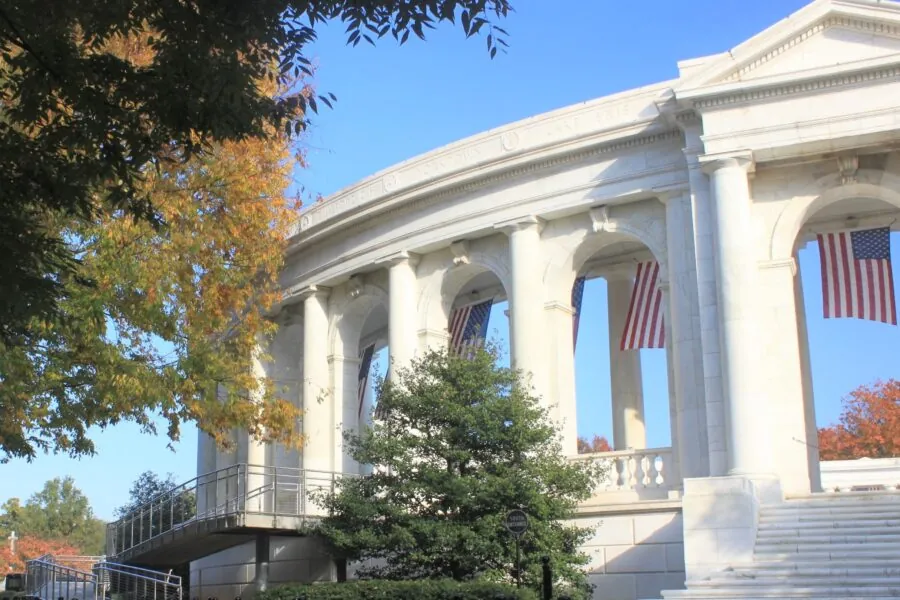RS&H Creates Inclusive Design for Historic Arlington National Cemetery

Known to the RS&H design team as a once-in-lifetime project, work on the Arlington National Cemetery’s (ANC) Memorial Amphitheater serves as a constant reminder of the meaning the site holds for a community of veterans, their families and our nation at-large.
The ANC will host a 100th anniversary ceremony for one of their most iconic memorials – the Tomb of the Unknown Soldier.
In preparation for the ceremony, the team provided field investigations and multi-discipline design services for areas throughout the amphitheater, reception hall and the plaza that surrounds the Tomb of the Unknown Soldier.
And to create a space that could be fully enjoyed, respected and accessed by all, the team incorporated accessibility improvements and accommodations that fit with the amphitheater’s design.
A Mission of Preservation
The amphitheater, which was dedicated in 1920, contains seating for approximately 5,000 people and serves as a site of great importance for veterans and their families.
“Working for the Arlington National Cemetery is a challenge, since the cemetery has a unique mission as the nation’s premier resting place for our soldiers dating back to the Civil War,” said Richard Hammett, Aerospace and Defense vice president. “The work requires historic preservation as well as a high level of precision in the designs.”
In 2014, ANC was placed on the National Register of Historic Places (NRHP) as a historic district, creating opportunities for RS&H to work with stakeholders in implementing improvements that meet rigorous standards.
“We worked closely with the clients to ensure each aspect of design met the required standards under Section 106 of the National Historic Preservation Act,” said Donna Hammerstein, structural engineer and project manager. “It took some extra coordination, but we were able to create a really elegant structure.”
The designs also met the Secretary of the Interior’s Preservation Standards and Guidelines for the Treatment of Historic Properties.
Making Rich History Accessible to All
The amphitheater has long stood as a symbol of great history and pride. Set on the site of the memorial cemetery, visitors come in awe of both the structure and the meaning it holds to a community of veterans.
An integral part of the amphitheater is the grand staircase that leads into the heart of the building. While an impressive element, it presented challenges for the team, who was tasked with making the historic structure accessible and compliant with the Americans with Disabilities Act (ADA).
“We went through many iterations of design for the accessible ramp and seating due to the tight timeline leading up to the ceremony,” said Donna. “By using beautiful pieces of reused historic marble, concrete, bronze, and stainless steel, we have been able to achieve a seamless, elegant look that perfectly suits the building and its visitors and stands the test of time.”
The result is an addition that optimizes both function and form, tying several design elements from the site together in the ramp design, and even taking inspiration from the Mast of the Maine Memorial as requested by ANC.
“The aesthetics of the ramp are heavily influenced by the ANC stakeholders,” said Kerry Felton, a key buildings and infrastructure architect on the project. “From the design of the thin profile of the concrete to the cable railing matching the Mast of the Maine, combining all elements without detracting from the historical elements of the amphitheater was key to this project.”
Multiple Perspectives Fuel Complex Design Elements
The team also provided accessibility improvements within the amphitheater – modifying seating accessibility in preparation for the ceremony.
The project required close coordination with the United States Army Corps of Engineers (USACE) Norfolk District, the National Park Service (NPS), and employees of the ANC; each stakeholder’s unique perspective played into the design in several areas.
“We took a lot of time to think about using modular systems and worked with structural and architectural associates to streamline the construction process and timeline,” said Kerry. “We had to think about how to get materials on the site quickly, how to erect accessible ramp quickly to limit the contractor’s time there and limit impact on the surrounding ground.”
Respectful design requires careful consideration, but it was a priority for the entire team to get it right for clients and visitors alike.
“The project has been successful due to communication and the team’s willingness to put our all into this structure,” said Donna. “We all appreciate the building and find it fascinating, and that comes through in our work.”
The team worked diligently to not only maintain the amphitheater’s historical and national elements, but also revitalize it for the benefit of all visitors and ceremony attendees for years to come.
The Final Reveal
Heartened by the site’s legacy of honor and pride and excited that the redesigned amphitheater will soon be used for the ceremony attended by the president, the RS&H team says this has been a once-in-a-lifetime project.
“Knowing that this project team has made such an impact on the community is an honor,” said Kerry. “It makes us feel like we’re making a real difference through our work.”
Learn more about the RS&H team, our project work and how we can take your projects to the next level in our RS&H Virtual Defense Room.
